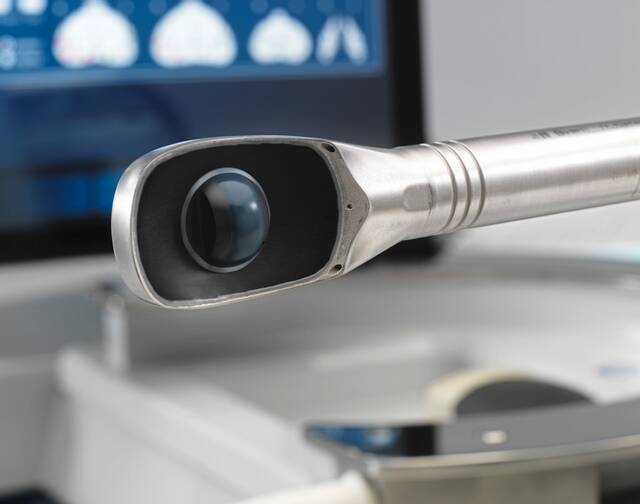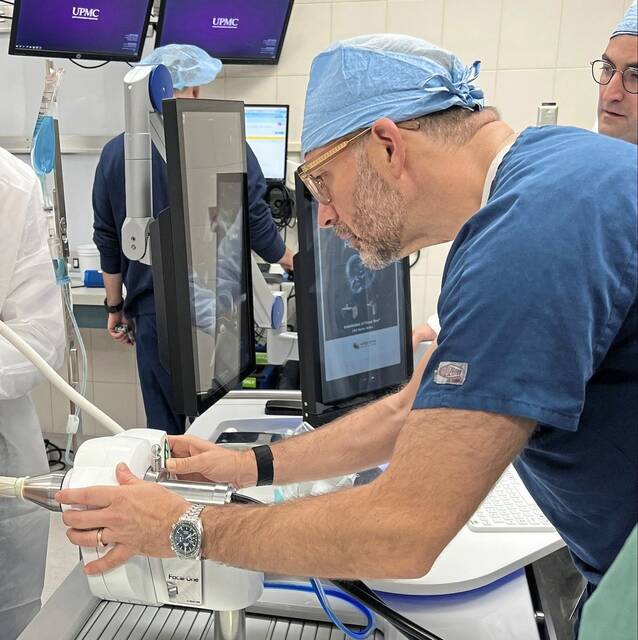Targeted ultrasound gives Pittsburgh-area doctors new tool against prostate cancer
Men diagnosed with prostate cancer have traditionally faced two choices: Do nothing and hope the tumor doesn’t grow between scans or start aggressive treatment.
Those with certain types of medium-risk cancers have lacked tailored care, caught between a surveillance strategy geared toward slow-growing tumors and drastic measures known for their potential sexual and urinary side effects.
But that’s starting to change at Western Pennsylvania hospitals with the rising use of high-intensity focused ultrasound, a targeted therapy that heats away cancer cells and leaves the healthy portion of the prostate intact.
“It really fills that middle ground very nicely,” said Dr. Kevin Bordeau, a urologist at St. Clair Hospital in Mt. Lebanon who will use the technology for the first time in January.
Doctors who use or will soon use high-intensity focused ultrasound caution only 10% to 20% of patients are eligible. It works best on cancers that are confined to a small area of the prostate and don’t appear to be spreading rapidly.
Patients are put under general anesthesia before having a rectal probe placed near their prostate. The machine takes an image of the gland and feeds it to doctors, who then direct the robotic probe to deliver tumor-destroying ultrasound waves.
The outpatient procedure takes no more than a few hours and requires minimal recovery.
Evidence is mounting of high-intensity focused ultrasound’s efficacy.
A 2022 clinical trial published in Lancet Oncology found nearly 90% of men who received high-intensity focused ultrasound had no medium-to-high risk cancer left on the gland after two years.
Crucially, there were no reports of incontinence and only a few cases of impotence, two side effects common after radiation or prostate removal.
“That’s why it’s becoming popular with patients,” said Dr. Ralph Miller, a urologist with Allegheny Health Network who has administered the treatment dozens of times since the health system began using it last year.
Most major cancer centers in the U.S. use this therapy, he noted.
Naturally, the treatment is not as effective at eliminating future cancer risk as taking out the entire gland, which comes with a four- to six-week recovery period.
“It’s important for patients to know this is a great treatment, but it comes with slightly higher recurrence rates and further imaging to make sure the disease is gone,” said Dr. Benjamin Davies, a urologic oncology surgeon at UPMC and urology professor at the University of Pittsburgh.
Any recurrences can still be treated using established methods.
Despite some drawbacks, thousands of men stand to benefit.
Nearly 300,000 men in the U.S. were diagnosed with prostate cancer last year, according to the American Cancer Society. More than 35,000 died of the disease, the group says, not all of them diagnosed that year.
The disease is almost always survivable when caught early but can be incredibly dangerous once it has spread beyond the prostate and nearby body parts.
The existence of a less aggressive yet still effective treatment might encourage more men to get screened for the disease, according to Bordeau.
The American Cancer Society recommends screening with a simple blood test starting at ages 40, 45 or 50, depending on a patient’s risk level. Black men are more likely to get prostate cancer, as well as men with a family history of the disease.
Evolving technology
Tuesday morning was UPMC’s first time performing the procedure.
“Frankly, we had been waiting for the technology to get better,” Davies said.
UPMC has adopted high-intensity focused ultrasound technology developed by Focal One, a Texas-based medical equipment maker. St. Clair is also buying these machines, while Allegheny Health Network has gone with North Carolina-based competitor Sonablate.
Independence Health Network does not offer high-intensity focused ultrasound to treat prostate cancer, according to Melissa Forster, a system spokeswoman.
West Virginia University Health System, which will take over Independence next year, did not immediately return a request for comment Thursday.
Focal One and Sonablate each tout their product as having an edge over the other, but the core function is the same. Both companies have benefited from technological leaps, such as the ability to layer past MRI images with live ultrasound images during treatment and destroy cancer with more precision.
“This is all happening in the last three to five years,” said Mohan Nathan, senior vice president of market development for Focal One.
There’s also a growing acceptance of high-intensity focused ultrasound by doctors and insurers as long-term, mostly positive data piles up. Besides prostate cancer, the technology is used to treat tumors in the brain, breast, liver and other areas, the Cleveland Clinic says.
Medicare began covering it as a treatment for prostate cancer in 2022, dramatically opening access to the procedure, since the disease mostly affects men older than 65.
In cases of recurrence, the American Urological Association says clinicians should present high-intensity focused ultrasound as an option.
The organization has no other “hard stances or statements” about its use, according to Corey Del Bianco, an American Urological Association spokeswoman.
Western Pennsylvania urologists expect the use of high-intensity focused therapy to become a consistent part of treatment plans.
“A lot of time a new treatment sort of adds to the older treatment and older treatments tend to evolve out over time,” Miller said.
Jack Troy is a TribLive reporter covering business and health care. A Pittsburgh native, he joined the Trib in January 2024 after graduating from the University of Pittsburgh. He can be reached at
Remove the ads from your TribLIVE reading experience but still support the journalists who create the content with TribLIVE Ad-Free.


